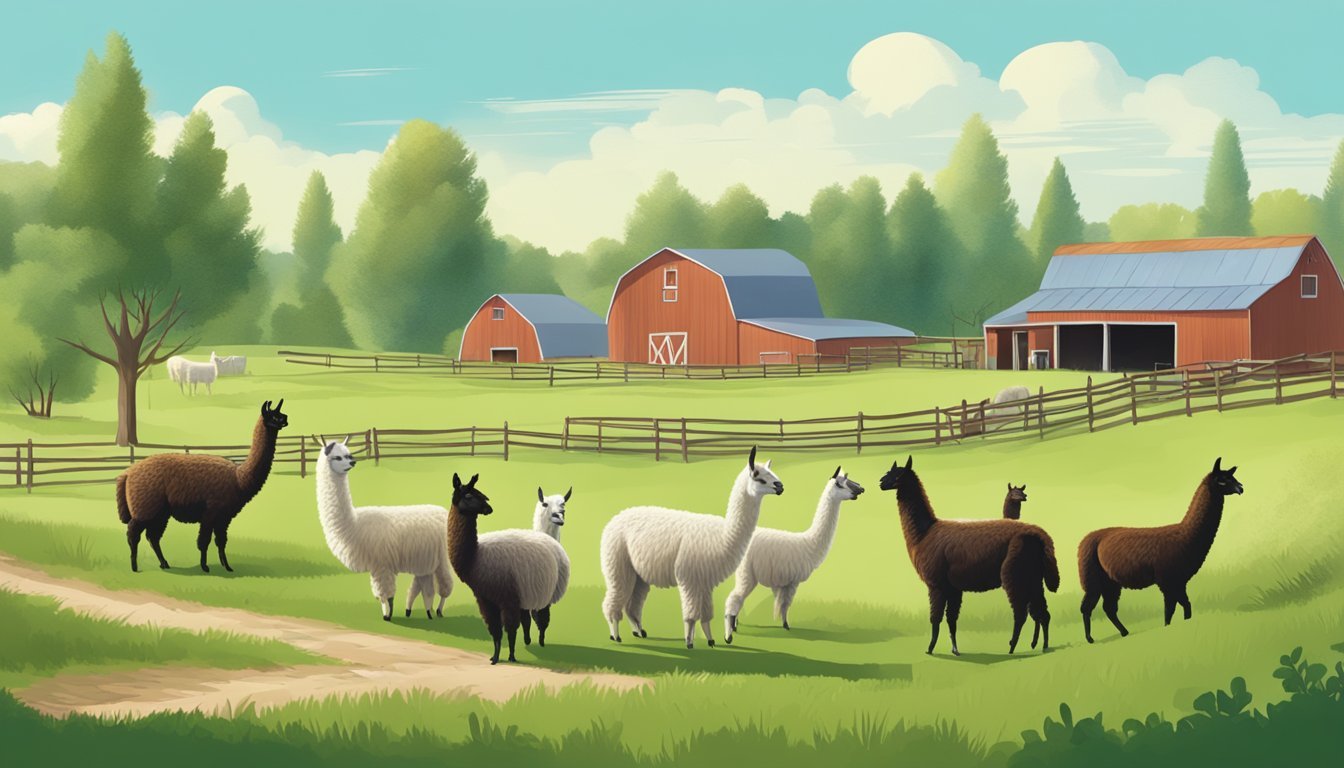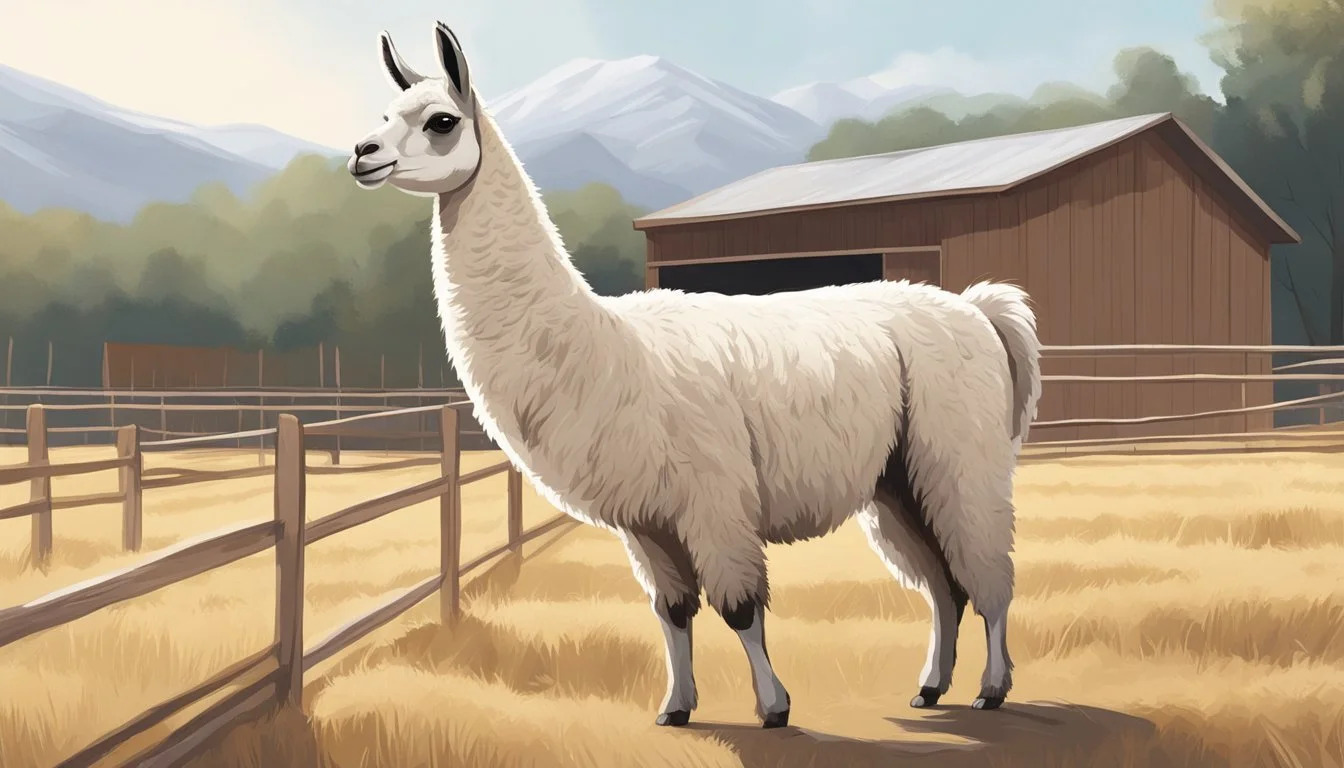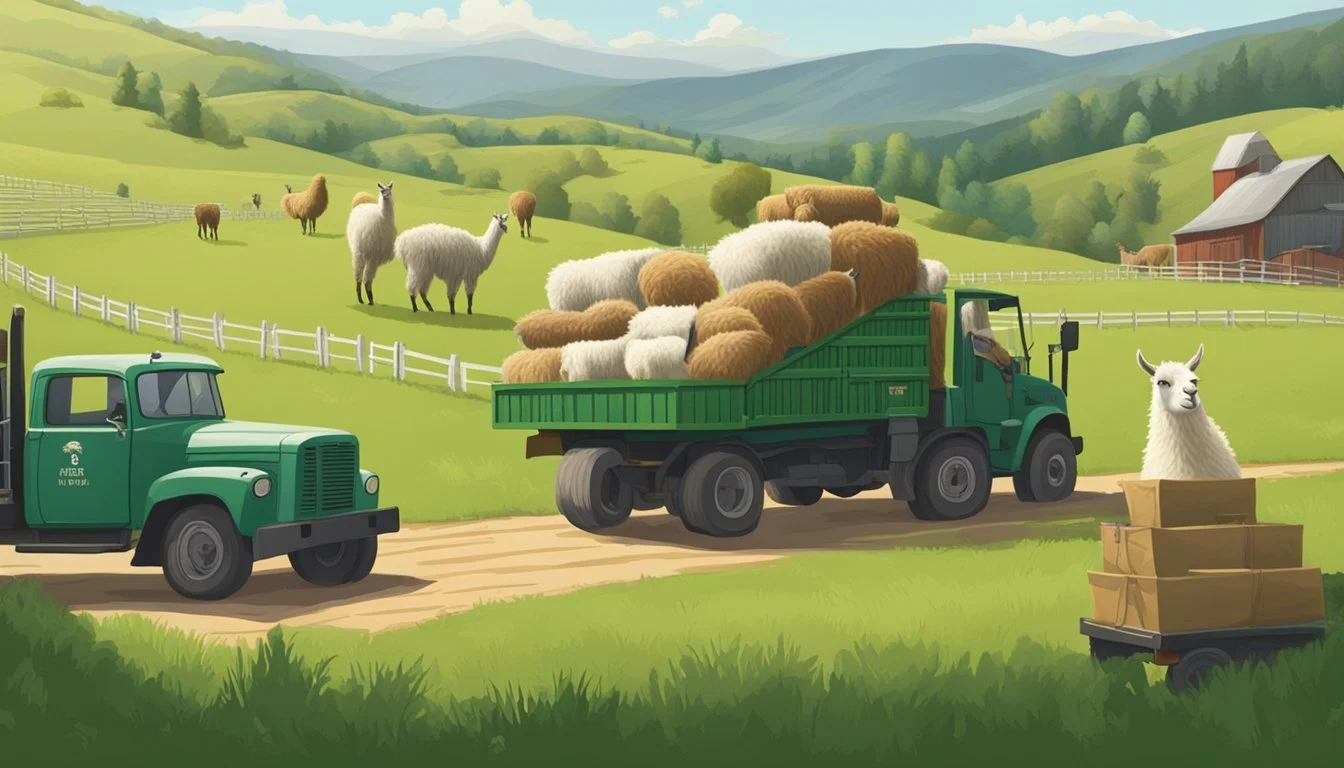Raising Llamas
Essential Tips for Success and Wellness
Raising llamas is a rewarding endeavor for those who have ample land and a passion for these unique animals. Originally domesticated in South America, llamas have made a name for themselves as versatile animals, serving various purposes such as livestock, pets, and even therapy animals in some cases. In recent years, their popularity has spread to the United States, where they have adapted well to various climates and environments.
Llamas are known for their curious and intelligent personalities, making them a fascinating addition to any farm or homestead. As social animals, llamas thrive best in a group and require proper care, including shelter, fencing, and regular veterinarian checkups. Despite being relatively low-maintenance compared to some other domesticated animals, taking on the responsibility of raising llamas entails a long-term commitment and dedication to their well-being.
When thinking about bringing herd animals like llamas onto your property, it's crucial to delve into the specifics and grasp the need to guarantee these creatures are properly looked after. This commitment involves being well-prepared for the responsibilities tied to raising llamas, be it providing them with the right mineral supplements or safeguarding them against potential threats like the meningeal worm.
Whether you're dealing with adult llamas, using a guard llama for protection, or joyfully raising a baby llama, it's all about creating a bond that lasts. Trips with llamas, set against the backdrop of green pastures, add an extra layer of joy to this experience. Owners need to be vigilant for signs of heat stress, ensuring llamas have access to cold water, as they prove to be excellent guardians when cared for properly. In the end, healthy llamas not only enrich their own lives but also forge a lasting connection with their human caretakers.
Understanding Llamas
Understanding llamas is essential, especially for those engaged in the llama industry or considering them as companion animals on their farm. Llamas, often kept as single individuals or in herds, contribute significantly to the industry through various avenues. Beyond their endearing nature, llamas provide valuable fiber from shearing, and their droppings can be used as fertilizer.
These intelligent animals also serve as excellent companion animals, forming bonds with humans and other farm animals. Owners must be aware of the specific needs of llamas, including proper nutrition, parasite control programs, and vigilance against common internal parasites. Whether raising a baby alpaca or integrating llamas into a farm setting, understanding their unique characteristics enhances the well-being of these fascinating creatures while fostering a harmonious coexistence with their human caretakers.
Species and History
Llamas belong to the camelid family, which consists of four species native to South America: llamas, alpacas, guanacos, and vicuñas. Llamas and alpacas are mainly domesticated, while guanacos and vicuñas remain wild. Llamas are believed to have been domesticated around 4,000-5,000 years ago, primarily used as pack animals and for their wool.
Physical Characteristics
Size: 4-6 feet (1.2-1.8 meters)
Weight: 250-450 lbs (113-204 kg)
Coat: Double coat with coarse and soft fibers
Llamas are relatively large animals, with a height of 4 to 6 feet at the top of their heads and weighing between 250 and 450 pounds. They possess a unique double coat, consisting of a coarse outer layer and a soft, insulating inner layer. Their coat can come in various colors, including white, black, brown, and gray.
Behavior and Temperament
Llamas are generally gentle and curious animals, known for their friendly temperament. Their social behavior allows them to live in herds and develop strong bonds with their owners and handlers. One notable aspect of llama behavior is spitting. Although typically reserved for disputes within the herd, llamas may spit at humans if they feel threatened or annoyed.
Understanding llama body language is crucial for proper care and management. Common signs of contentment and relaxation include humming, a slightly open mouth, and a calm posture. Signs of discomfort or distress can manifest as laying ears back, stomping feet, and frothing at the mouth.
Llama Care Essentials
Llama Care Essentials encompass a range of practices vital for the well-being of these remarkable creatures, whether you have a single llama or a herd. Regular shearing not only provides valuable fiber but also aids in temperature regulation for their comfort.
Managing llama droppings is another crucial aspect, as they can be repurposed as effective fertilizer. For those nurturing a baby alpaca, special attention to nutrition and healthcare is essential to ensure healthy growth.
Additionally, implementing measures to prevent and address common parasites is imperative. Regular veterinary checks and parasite control programs play a key role in maintaining the overall health and vitality of llamas.
Considerations When Acquiring Adult Llamas
When acquiring adult llamas, several considerations play a crucial role in ensuring their well-being. Understanding their adult weight is essential for proper care and nutrition planning. For those places with cold temperatures, particularly during cold nighttime conditions, providing appropriate shelter, such as three-sided shelters, becomes imperative.
If acquiring a pregnant female, additional attention to her needs is necessary, ensuring a conducive environment for a healthy gestation period. Introducing new llamas to an existing group requires a patient approach, considering the dynamics of dominant llamas. Gradual introduction minimizes stress and potential conflicts, fostering a harmonious herd.
Llama owners should also be mindful of providing essentials like mineral blocks to meet nutritional requirements. The ideal time for acquiring adult llamas may vary, but well-prepared and patient llama owners can navigate the process with minimal safety risks and set the stage for a positive and healthy integration into their new environment.
Nutrition and Diet
Their primary source of food should be hay and grass, as they are natural grazers. Offer them alfalfa sparingly as it is high in protein and can lead to obesity if not properly managed.
Maintaining llamas' well-being extends beyond their diet to encompass various aspects of their care. Regular care involves not only ensuring a balanced diet, considering body condition and the types of livestock sharing the space but also implementing a parasite treatment plan to safeguard their health. Pasture rotation is crucial, especially if llamas share space with other species of livestock, as it helps manage parasite loads and promotes overall pasture health.
In addition to nutrition, other aspects of regular care include monitoring the risk for heat stress, particularly in warmer climates. Adequate shade and ventilation should be provided to keep llamas healthy during hot weather. Nail trimming is essential to prevent discomfort and promote proper movement, especially considering their furry coat, which might make it more challenging to notice overgrown hooves.
A llama's diet should include:
Hay or grass (80-90%)
Alfalfa (10-20%)
Freshwater
Additional nutrition such as protein and vitamin supplements may be necessary in some cases. Consult a veterinarian for advice on any needed supplements.
Shelter and Space
Llamas need adequate shelter and space to graze, exercise, and rest comfortably. A well-built fencing system is essential to keep llamas safe from predators.
Proper shelter and space requirements include:
Space: 1 acre per 3-5 llamas
Fencing: 4-5 feet high
Shelter: three-sided, ventilated, and covered area
Proper ventilation and clean, dry bedding should be provided in the shelter to ensure overall comfort and health.
Health and Veterinary Care
Making regular visits to a veterinarian specializing in llamas is crucial for their overall well-being. This includes meticulous record-keeping of health information, such as vaccinations and deworming schedules, and any other necessary medical care.
Llamas are susceptible to conditions like intestinal toxemia and malignant edema, making preventative measures paramount. Veterinary professionals may administer injectable anesthetics for various procedures, highlighting the importance of expert care. Despite their reputation for spitting, llamas can be cooperative during medical examinations with the right approach, and these painstaking efforts in healthcare contribute to their long-term health and happiness.
Some essential healthcare measures include:
Vaccinations: as recommended by a veterinarian
Deworming: regularly, using ivermectin or similar products
Monitoring for diseases and parasites
Ensure your llamas have access to clean, fresh water at all times to maintain their health.
Grooming and Handling
Regular grooming and handling of llamas can help develop trust and a strong bond between the animal and its caretaker. This also allows the owner to easily monitor for any health issues or parasites.
Key aspects of grooming and handling include:
Brushing: to remove dirt and loose hair
Shearing: annually or biannually, as needed
Hoof care: regular trimming and inspection
Handling: gentle, confident, and consistent approach
By providing adequate care on a daily basis in the areas of nutrition, shelter, health, and grooming, llamas can lead healthy and happy lives. It's important to ensure that their diet includes protein supplementation and that they have access to a cooler environment during hot weather. Fecal testing and proper vaccines are also crucial in maintaining their health.
Additionally, ensuring guards for herds, monthly boosters, and positive reinforcement can improve their overall energy level and newborn survival rate. Wet conditions can be a risk factor for llamas, so it's important to take extra care during these times. Remember to consult with a veterinarian or experienced llama caregiver for further guidance and support in any specific care requirements, such as pasture breeding.
Reproductive Health and Breeding
Breeding Practices
When breeding llamas, it is crucial to select healthy, mature animals to ensure successful reproduction. Female llamas, known as dams, typically become receptive to breeding around 18-24 months. Males, or sires, should be at least 3 years old before beginning their breeding career. It's important to note that llamas are induced ovulators, which means that the act of breeding stimulates ovulation.
To maximize their chances of connecting, breeders should allow the male and female llamas to mate in brief, controlled sessions. It is essential to provide ample space so the mating pair can roam freely, while still being careful of any potential dangers, such as predatory animals.
Caring for Pregnant Llamas
The average gestation period for llamas is around 350 days. During pregnancy, frequent examination by a veterinarian is crucial for monitoring the health of both the dam and the developing cria. Pregnant llamas should receive an ample diet high in essential vitamins and minerals. In particular, one should be cautious of selenium deficiencies, as they can lead to adverse health outcomes. Regular vaccination against diseases like tetanus is crucial to ensure the safety of the pregnant llama and her offspring.
Some breeders may choose to confine pregnant llamas to a smaller, more controlled environment during the weeks leading up to birth. This confinement helps keep an eye on the dam, swiftly identifying signs of labor and providing assistance to the cria as needed.
Birth and Cria Care
When a llama enters labor, the breeder or veterinarian needs to monitor the birth closely. In the event of complications, swift intervention is essential. Once the cria is born, the breeder should immediately check for signs of distress, such as labored breathing or movement difficulties.
Crias require diligent care in their first weeks of life to ensure optimal health and growth. Temperature regulation is a critical aspect of cria care. In colder climates, it may be necessary to provide heat lamps or blankets to keep the newborn warm.
Additionally, breeders should watch for successful nursing within the first few hours of birth, ensuring that the cria receives critical nutrients and antibodies. Lactating dams have crucial nutritional needs that breeders must address with a suitable diet.
Finally, castration of male crias should be considered around six months of age, as it helps prevent breeding-related aggression and injuries. This procedure should be performed by an experienced veterinarian. By providing attentive care during the birthing process and the cria's early life, breeders can ensure the long-term health of their beloved llama herd.
Practical Uses and Economic Value
Fiber Production and Uses
Llama fiber, also known as llama wool or llama fleece, is highly valued for its versatility and warmth. Llama wool contains two different types of fiber: an inner, soft undercoat, and an outer, coarser guard hair layer. During the shearing process, these layers are separated, allowing them to be utilized for various purposes.
The finer, inner coat can be made into high-quality textiles, such as clothing, blankets, and accessories.
The coarser, outer coat has multiple uses including ropes, rugs, and insulation materials.
Llama wool is also hypoallergenic, making it an appealing option for those with sensitivities to other fibers such as sheep's wool.
Llamas as Working Animals
Llamas have historically served as pack animals, particularly in their native South America. Their natural strength, endurance, and sure-footedness make them ideal for carrying heavy loads across rugged terrain. Some advantages of using llamas as working animals include:
Pack animals: Llamas can carry loads up to about 30% of their body weight, making them useful for homestead or wilderness tasks.
Guard animals: Llamas possess inherent guarding abilities, defending livestock from potential predators without physical aggression.
Companionship: Llamas are gentle and sociable, proving to be both good pets and reliable working partners with proper training.
Llamas in Agriculture
Llamas not only provide economic value through their fiber and work capacity, but they also hold agricultural benefits. As livestock, they contribute to the overall maintenance and sustenance of a homestead or farm. Key aspects include:
Manure: Llama manure, rich in nutrients, greatly benefits the soil, resulting in improved crop growth.
Meat: Though not the most prominent aspect of their value, llama meat is lean and rich in protein, providing another potential resource on a farm.
Sustainable grazing: Llamas have a light ecological footprint due to their soft footpads, and their selective browsing habits help maintain pasture quality.
Incorporating llamas into a farming or homestead setting can diversify the enterprise while benefiting both the environment and the landowner.





